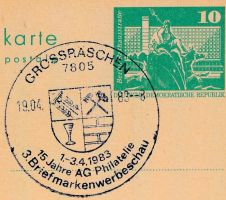Großräschen: Difference between revisions
Knorrepoes (talk | contribs) m (Text replacement - "<gallery widths=250px heights=200px perrow=0>↵" to "===Image Gallery=== <gallery widths=250px heights=200px perrow=0> ") |
Knorrepoes (talk | contribs) m (Text replacement - "===Image Gallery===" to "===Image gallery===") |
||
| Line 29: | Line 29: | ||
In the previous arms the glass and wall represented the glass and brick industries in the town. The quartering indicated the four original villages from which the town developed. | In the previous arms the glass and wall represented the glass and brick industries in the town. The quartering indicated the four original villages from which the town developed. | ||
===Image | ===Image gallery=== | ||
<gallery widths=250px heights=200px perrow=0> | <gallery widths=250px heights=200px perrow=0> | ||
File:grossras.jpg|alt=Wappen von Großräschen/Arms (crest) of Großräschen|The arms from 1948 | File:grossras.jpg|alt=Wappen von Großräschen/Arms (crest) of Großräschen|The arms from 1948 | ||
Revision as of 08:24, 3 September 2023
GROSSRÄSCHEN
State : Brandenburg
District (Kreis) : Oberspreewald-Lausitz
Additions: 1946 Bückgen, Schmogro; 1974 Dörrwalde; 1997 Freienhufen; 1998 Woschkow; 2001 Allmosen, Barzig, Saalhausen, Wormlage
Amt : 1992-2001 Amt Großräschen
| German | Schräg gevierteilt von Rot und Silber; oben eine wachsende silberne Harke mit sieben Zinken; links ein aufrechter schwarzer Buchenzweig mit acht Blättern, rechts gekreuzte schwarze Schlägel und Eisen, unten drei zu einem Dreischenkel zusammengestellte silberne Hufeisen. |
| English | blazon wanted |
Origin/meaning
The arms were officially granted on April 12, 2002 replacing arms adopted on May 17, 1948. The arms were originally granted to the Amt Großräschen.
The miner's tools indicate the importance of mining and industry in the history of the town. The rake is a canting element (Räschen = Rechen, meaning rake) and is taken from the historical seal of the village. Both elements were already part of the arms used during DDR times, see below. In the previous arms the wheatears next to the rake were a symbol for agriculture.
The beech branch is a symbol for the reforestation after the mining activities. The three horseshoes are taken from the arms of Freienhufen (hufe=hoove).
In the previous arms the glass and wall represented the glass and brick industries in the town. The quartering indicated the four original villages from which the town developed.
Image gallery
This page is part of the German heraldry portal Deutsche Wappensammlung |
Heraldry of the World |
|
German heraldry:
|
Selected collector's items from Germany:
|
Contact and Support
Partners:
Your logo here ?
Contact us
© since 1995, Heraldry of the World, Ralf Hartemink 
Index of the site
Literature: Benzing et al, 1984; MOZ














